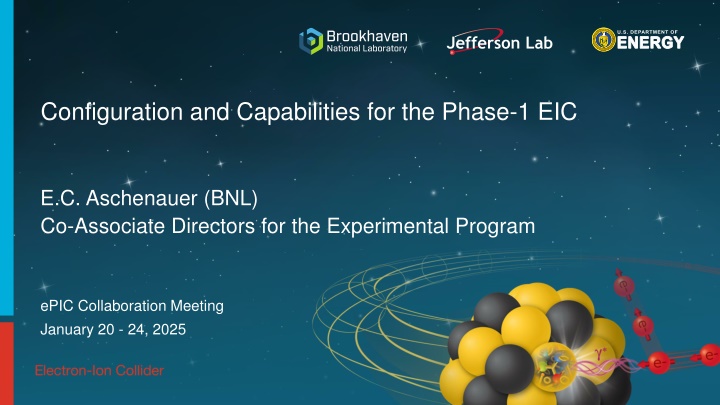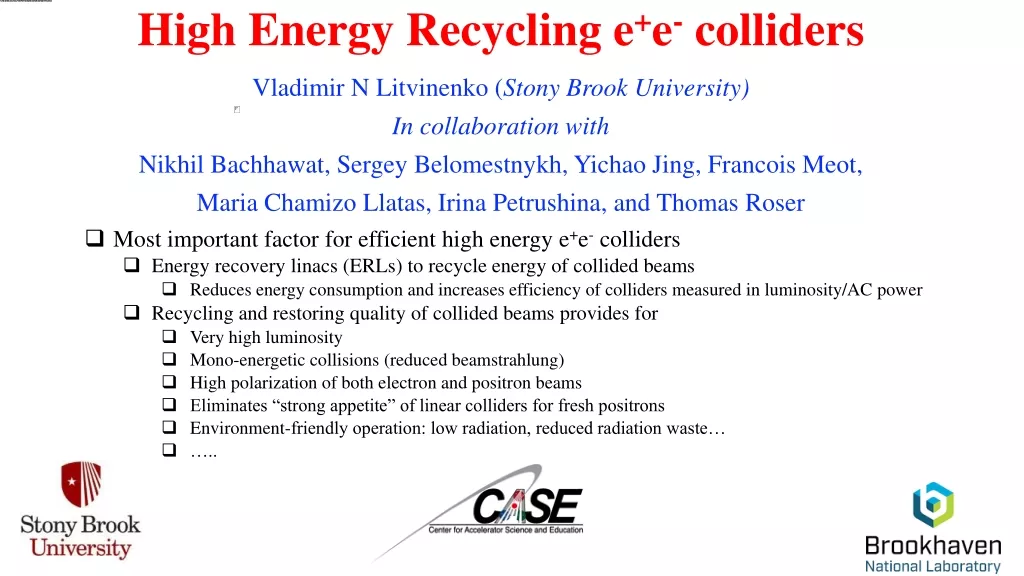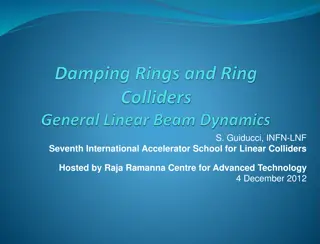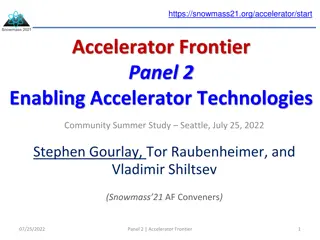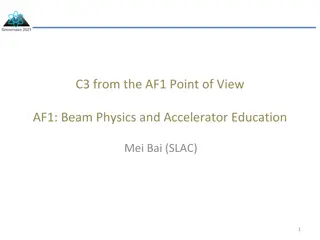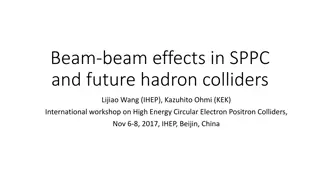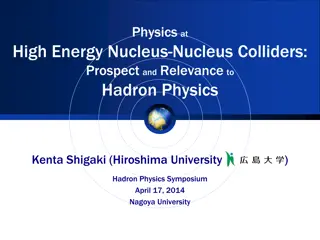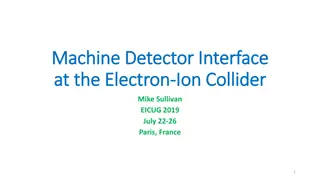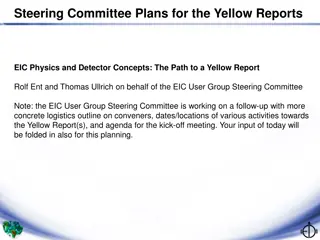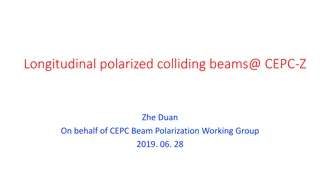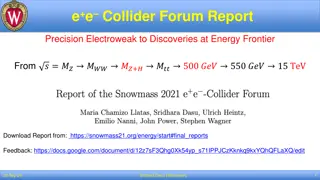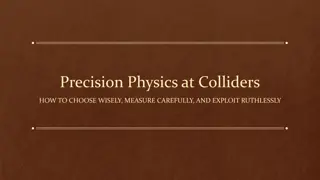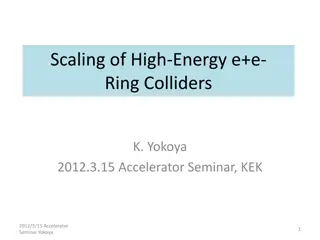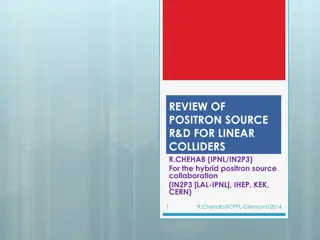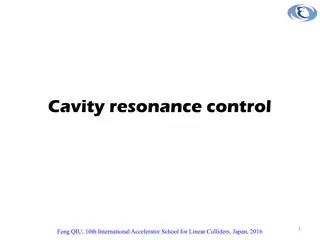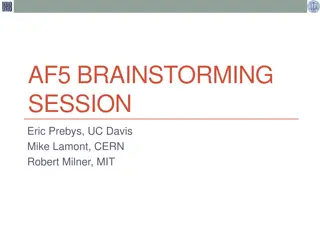Phase-1 EIC Capabilities & Lessons from Colliders
Configurations and capabilities for the Phase-1 EIC discussed at a collaboration meeting in January 2025. Insights from recent colliders like KEKB, SuperKEKB, and HERA II upgrade are shared, highlighting challenges and lessons learned. Issues such as beam instabilities, beam backgrounds, vacuum conditions, and beam-gas interactions are addressed, emphasizing the importance of careful planning and simulations for successful upgrades.
Download Presentation

Please find below an Image/Link to download the presentation.
The content on the website is provided AS IS for your information and personal use only. It may not be sold, licensed, or shared on other websites without obtaining consent from the author.If you encounter any issues during the download, it is possible that the publisher has removed the file from their server.
You are allowed to download the files provided on this website for personal or commercial use, subject to the condition that they are used lawfully. All files are the property of their respective owners.
The content on the website is provided AS IS for your information and personal use only. It may not be sold, licensed, or shared on other websites without obtaining consent from the author.
E N D
Presentation Transcript
Configuration and Capabilities for the Phase-1 EIC E.C. Aschenauer (BNL) Co-Associate Directors for the Experimental Program ePIC Collaboration Meeting January 20 - 24, 2025
Experience ramping up KEKB and SuperKEKB KEKB took ~5 years to reach design luminosity SuperKEKB has not yet reached design luminosity > 20 below goal operating since 2019 Several reasons, beam instabilities and beam backgrounds E.C. Aschenauer & R. Ent ePIC Collaboration Meeting, January 2025
Lessons from HERA II upgrade HERA performed an upgrade to increase luminosity by a factor of 5 Mainly by squeezing the beam more at the IP by redesign of the IR The upgrade increased backgrounds dramatically Several month shutdown to implement improvements Electron beam polarization never reached HERA-I levels, H1 and Zeus solenoids (~1T) not well compensated Main culprits: no careful simulations prior to the upgrade Proton beam-gas interactions most severe background Needed an extremely good vacuum to mitigate this Synchrotron radiation background Background to detectors Excess heating of beam pipe Can damage flanges, etc. Can heat beam pipe, decreasing vacuum Electron beam-gas E.C. Aschenauer & R. Ent ePIC Collaboration Meeting, January 2025 4 E.C. Aschenauer
Lessons from HERA II upgrade Dynamic pressure increase due to thermal and photo desorption Pressure vs. integrated electron current 2002 - 03 Proton Beam Gas Background Two time constants for vacuum conditioning Short term after leaks 20 30 days Long term 600 days E.C. Aschenauer & R. Ent ePIC Collaboration Meeting, January 2025 5 E.C. Aschenauer
Lessons from HERA II upgrade Electron polarization through Sokolov Ternov Luminosity and Polarization have been strongly anti-corelated E.C. Aschenauer & R. Ent ePIC Collaboration Meeting, January 2025 6
Lessons learnt from pp Colliders RHIC Tevatron LHC The pbar electron cooler was added in July of 2005. The initial luminosity increased by ~50% at first and then it took many years to take advantage of the cooler by optimizing the store length, beam-beam interactions, etc. First beam September 10th,2008, malfunction 9 days later no beam for experiments till 2010, March 19th, 2010 collisions at 7 TeV Design Lumi was reached June 2016 13.6 TeV reached April 2022 First Beam in 2000 Polarization and Luminosity often anti- corelated. Took in 2015 in one year the integrated luminosity from all the years before at s=100 GeV and for s=250 GeV in 2017 E.C. Aschenauer & R. Ent ePIC Collaboration Meeting, January 2025 7
EIC and Subprojects Early Science EIC Full Capabilities Collider (ESR + HSR) Subproject 1 Electron Injector Subproject 3 Accelerator, Subproject 4 Detector + IR Subproject 2 + + All the scope needed for mission need All the scope needed to reach full EIC capabilities E.C. Aschenauer & R. Ent ePIC Collaboration Meeting, January 2025 9
EIC NAS Science Pillars The EIC will unravel the different contribution from the quarks, gluons and orbital angular momentum How can we understand their dynamical origin in QCD? What is the relation to Confinement How are the quarks and gluon distributed in space and momentum inside the nucleon & nuclei? How do the nucleon properties emerge from them and their interactions? How do the confined hadronic states emerge from quarks and gluons? Does the mass of visible matter emerge from quark-gluon interactions? What happens to the gluon density in nuclei? Does it saturate at high energy? Atom: Binding/Mass = 0.00000001 Is the structure of a free and bound nucleon the same? How do quarks and gluons, interact with a nuclear medium? How do the quark- gluon interactions create nuclear binding? How many gluons can fit in a proton? How does a dense nuclear environment affect the quarks and gluons, their correlations, and their interactions? ? = splitting SPIN is one of the fundamental properties of matter. All elementary particles, but the Higgs carry spin. Spin cannot be explained by a static picture of the proton It is the interplay between the intrinsic properties and interactions of quarks and gluons Nucleus: Binding/Mass = 0.01 Proton: Binding/Mass = 100 For the proton the EIC will determine an important term contributing to the proton mass, the so- called QCD trace anomaly gluon gluon recombination E.C. Aschenauer & R. Ent ePIC Collaboration Meeting, January 2025
Accelerator at Day One and Ultimate Early Science Program Full EIC Capabilities RCS: 7nC / bunch 5 10 GeV polarized e- and add RF to accelerate to 18 GeV electrons 7nC / bunch Add more RF cavities to operate at 18 GeV electrons 5 10 GeV polarized e- and 28 nC / bunch Add an accumulation ring to reach 28 nC / bunch ESR: HSR: 100 250 GeV polarized p Update PS to reach 275 GeV protons and 110 GeV/u nuclei 100 GeV/u nuclear beams add 41 GeV bypass to get full HSR beam energy capabilities cooling at injection energy Proposal for the Day-One Physics and the initial years of science is driven by Start of the promised NSAC/NAS science program Alignment with expected order in commissioning the collider and ramp up of performance that comes with gain of operational experience Having access to new physics results early to get high impact publications, i.e. PRLs, E.C. Aschenauer & R. Ent ePIC Collaboration Meeting, January 2025 11
Accelerator Performance for NAS Science EIC Mission Need & Early science program Full EIC capabilities map the out nucleon and nuclei structure from high to low x span center-of-mass energy s: 45 100 GeV wide center-of-mass energy: s: 30 140 GeV access to spin structure of nucleons and nuclei Spin vehicle to access the spatial and momentum structure of the nucleon in 3d quark gluon structure of light nuclei polarized electron and hadron (p, He-3) beams gluon emission gluon recombination accessing the highest gluon densities saturation How quarks and gluons interact with a nuclear medium nuclear beams: d to Pb at s: 45 63 GeV nuclear beams: d to Pb at s: 30 90 GeV access to highest & lowest x ? = mapping the spatial and momentum structure of nucleons and nuclei in 3d high luminosity 1033 cm-2s-1 large acceptance in pT (0.2 1.3 GeV) through forward focusing IR magnets access to rare probes, i.e. Ws and BSM Physics precision mapping the spatial and momentum structure of nucleons and nuclei in 3d high luminosity: > 1033 cm-2s-1 E.C. Aschenauer & R. Ent ePIC Collaboration Meeting, January 2025
What will be installed for the early science program Goal: central ePIC has all subsystems installed Ancillary detectors all supports are installed, but some of the detector packages are not installed for safety reason for year 1. ZDC and Lumi-detector are fully installed Off-Momentum detectors should be in save position, so they can be used if beam is stable Roman Pots will not be installed low Q2 Tagger should be discussed hadron and electron polarimetry will be installed from day-1 operating EIC Electrons Hadrons Ring Inside B0 Magnets & Detectors pC Hadron Polarimeter Rear Photon Beam Far Forward SC Magnets Luminosity Monitor SC Magnets Dipoles Electron Storage Ring Hadron Storage Ring Off Momentum Detectors Zero Degree Calorimeter Roman Pots Low Q2 Taggers Ring Outside E.C. Aschenauer & R. Ent ePIC Collaboration Meeting, January 2025 13
What do we need to commission RCS: operate the RCS get polarization in the RCS swap out of electron bunches in the ESR ESR: operating with spin rotator to get longitudinal polarization swap out of electron bunches to preserve polarization, needed because Sokolov Ternov depolarizes up spin direction Maximum replacement times (= max. allowable storage times in ESR) are based on 85% injected polarization and 70% time averaged polarization HSR: operating beams off center transverse and longitudinal beam polarization (needs spin rotator) for protons and He-3 pre-cooling of hadron beams operating with crab cavities E.C. Aschenauer & R. Ent ePIC Collaboration Meeting, January 2025 14
Beam Energy and Average Orbit Radius in the HSR 20 3He p 15 20 mm 10 5 store 130 GeV 275 GeV 100 GeV D DR, mm 0 90 110 130 150 170 190 210 230 250 270 -5 70 mm beam pipe E, GeV/u -10 Since the electron revolution frequency is fixed, the hadron orbit must be adjusted with energy to keep the collisions in sync. -15 d U Au, Zr Ru p Cu -20 1. Prefer ~130 GeV/u, which corresponds to a centered hadron beam (path length difference R ~ 0, this is achieved for a beam where Z ~ 0.5A) Ru, Cu, Ag, .. 2. Do not want to exceed the present RHIC maximum dipole fields (corresponds to 250 GeV protons or 833 T-m) E.C. Aschenauer & R. Ent ePIC Collaboration Meeting, January 2025 15
EIC Science Program in the early Years of EIC Proposal to bring EIC online got feedback from ePIC Leadership June 2024 Detector Advisory Committee Meeting June 2024 Users during EIC-UG/ePIC Summer Meeting July 2024 EIC Project Strategy Workshop August 2024 EIC@JLab Friday meeting September 2024 ePIC dedicated meeting on early science September 2024 Machine Advisory Committee Meeting September 2024 EIC CD-3B and Status Directors review October 2024 EIC RRB Meeting November 2024 EIC DOE OPA CD-3B LLP Review January 2025 E.C. Aschenauer & R. Ent ePIC Collaboration Meeting, January 2025
Proposal for EIC Science Program in the First Years Year - 2 Phase 1 EIC + electron polarization New Capability: Commission proton polarization in parallel Run: 10 GeV polarized electrons on 130 GeV/u Deuterium Physics: Add your preferred science topic Year - 3 Year - 5 Phase 1 EIC + electron polarization + proton polarization + operation of hadron spin rotators + operation of hadron beams with not centered orbits Run: 10 GeV polarized electrons on 100 GeV Au Physics: Add your preferred science topic Year - 4 Year - 1 Phase 1 EIC + electron polarization + proton polarization New Capability: Commission running with hadron spin rotators Run: 10 GeV polarized electrons on 130 GeV transverse polarized protons Physics: Add your preferred science topic Phase 1 EIC + electron polarization + proton polarization + operation of hadron spin rotators New Capability: Commission hadron accelerator to operate with not centered orbits Run: 10 GeV polarized electrons on 100 GeV Au Physics: Add your preferred science topic Start with Phase 1 EIC New Capability: Commission electron polarization in parallel Run: 10 GeV electrons on 115 GeV/u heavy ion beams (Ru or Cu) Physics: Add your preferred science topic Run: Last weeks 10 GeV electrons and 130 GeV polarized protons Physics: Add your preferred science topic Run: 10 GeV electrons on 166 GeV transverse and longitudinal polarized He-3 Physics: Add your preferred science topic Run: Last weeks switch to longitudinal proton polarization Physics: Add your preferred science topic Run: 10 GeV electrons on 250 GeV transverse and longitudinal polarized protons Physics: Add your preferred science topic Time to install additional ESR RF and HSR PS to reach design Current and max. Energies E.C. Aschenauer & R. Ent ePIC Collaboration Meeting, January 2025 17
Proposal for EIC Science Program in the First Years Year - 5 Year - 6 Year - 7 Phase 1 EIC + electron polarization + proton polarization + operation of hadron spin rotators + operation of hadron beams with not centered orbits New Capability: Commission ESR & HSR at max. energy and beam currents Run: 18 GeV polarized electrons on 275 GeV/u polarized (longitudinal & transverse) proton beams Physics: Add your preferred science topic Phase 1 EIC + electron polarization + proton polarization + operation of hadron spin rotators + operation of hadron beams with not centered orbits + operation of ESR & HSR at max. energy and beam currents New Capability: Operate HSR with 41 GeV bypass Run: 5 GeV polarized electrons on 41 GeV transverse polarized proton beams Physics: Add your preferred science topic Phase 1 EIC + electron polarization + proton polarization + operation of hadron spin rotators + operation of hadron beams with not centered orbits Run: 10 GeV polarized electrons on 100 GeV Au Physics: Add your preferred science topic Run: 10 GeV electrons on 166 GeV transverse and longitudinal polarized He-3 Physics: Add your preferred science topic E.C. Aschenauer & R. Ent ePIC Collaboration Meeting, January 2025 18
Assumptions and Luminosity Calculation 7 nC electron bunch charge compared to 28 nC (CDR) Constant proton beam IP divergencies are maintained throughout the store by gradual increase of proton IP beta-functions as the beam emittance increases. The electron IP beta-functions are adjusted accordingly to match electron and proton transverse beam size. Ion beam is cooled at low energy (24 GeV/u) but no stochastic cooling is used in the store 1 Run is year operation at 80% uptime 2 h store turnaround time 30 min at the beginning of the store is taken by the ESR fill and detector turn-on Integral Ave. lumi = store length + 2.5 hr Not yet included a ramp of of luminosity through the Run at RHIC: 1st week 25% of projected lumi / week 2nd week 50% of projected lumi / week 3rd week 75% of projected lumi / week 4th week to X week 100% of projected lumi / week First guess for EIC early years 1st week 10% of projected lumi of the run / week increase by 10% every 10 weeks to reach projected lumi / week E.C. Aschenauer & R. Ent ePIC Collaboration Meeting, January 2025
Assumptions and Luminosity Possible Beam energies: electron: 5 GeV, 10 GeV and ultimately 18 GeV proton: 41 GeV, 100 GeV to 255 GeV ultimately 275 GeV Au: 41 GeV, 100 GeV to 110 GeV ultimately A: 41 GeV, 100 GeV to Max ~255 / (A/Z) ultimately ~275 / (A/Z) eA luminosities for Phase-I Lumi per Fill (5 h) 1.3 pb-1 1.2 pb-1 16 pb-1 12 pb-1 Lumi per Year 0.9 fb-1 0.84 fb-1 11.4 fb-1 8.65 fb-1 10 GeV e x 115 GeV Ru 10 GeV e x 100 GeV Au 10 GeV e x 130 GeV d 10 GeV e x 166 GeV 3He Note: eA luminosity is per nucleon E.C. Aschenauer & R. Ent ePIC Collaboration Meeting, January 2025
ep Luminosity for Phase-1 High Divergence Lumi per Fill (5 h) 9.26 pb-1 13.12 pb-1 6.3 pb-1 7.6 pb-1 Lumi per Year 6.48 fb-1 9.18 fb-1 4.36 fb-1 5.33 fb-1 Low Divergence Lumi per Fill (5 h) 6.81 pb-1 8.8 pb-1 5.8 pb-1 7.1 pb-1 Lumi per Year 4.78 fb-1 6.19 fb-1 4.1 fb-1 4.95 fb-1 5 GeV e x 250 GeV p 10 GeV e x 250 GeV p 5 GeV e x 130 GeV p 10 GeV e x 130 GeV p 5 GeV e x 250 GeV p 10 GeV e x 250 GeV p 5 GeV e x 130 GeV p 10 GeV e x 130 GeV p Compare to HERA integrated luminosity 1992 2007: 0.6 fb-1 Remember: high divergence: higher lumi, but reduced acceptance for low forward particle pTmin low divergence: lower lumi, but increased acceptance for low forward particle pTmin important for exclusive processes Illustration Low-divergence E.C. Aschenauer & R. Ent ePIC Collaboration Meeting, January 2025
Luminosity ep for Phase-1 Compare to HERA peak luminosity of 5x1031cm-2sec-1 Max average luminosity without SHC: 0.8 x 1033 cm-2 s-1 with 5.9 hr store 250 GeV x 10 GeV E.C. Aschenauer & R. Ent ePIC Collaboration Meeting, January 2025
Initial thoughts on the EIC Commissioning Strategy Science Requirement for Polarisation: need high polarization (~70%) experimental uncertainties proportional to 1/(Pe2PA2L) or 1/(Pe/A2L) depending on measurements (single or double spin dependent observables) if electron polarization is required, it needs to be always longitudinal requires ESR spin rotators to limit systematics optimum would be to have arbitraryspin patters for both HSR and ESR HSR: have trains of 4 bunches with the same spin direction ESR: using RCS allows for arbitrary spin patters in the ESR through replacements Running at 5 and 10 GeV electrons: we want polarization as early as possible, depolarization is small max allowable replacement time for 10 GeV 360 mins (85% 70%) for the preferred polarization state and 96 mins for opposite direction proposal run only the preferred spin state per fill backup to swap out option in case backgrounds at detector would be high Consequence: need to flip the ESR spin rotators between fills to keep systematics small possible; optics does not depend on spin rotator polarity and in the shadow of filling the HSR we change spin rotator polarity in ESR Maximum replacement times (= max. allowable storage times in ESR) are based on 85% injected polarization and 70% time averaged polarization E.C. Aschenauer & R. Ent ePIC Collaboration Meeting, January 2025 25
